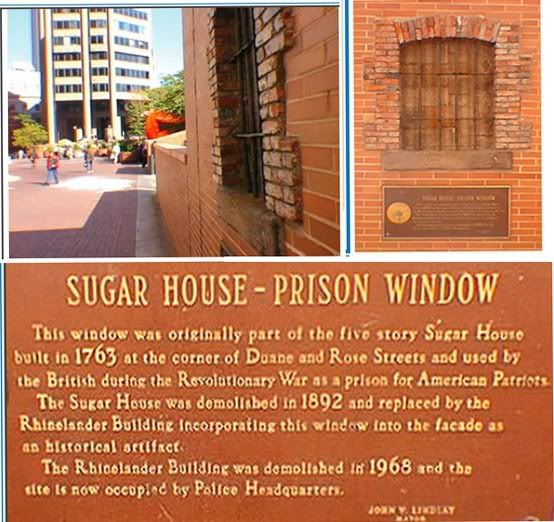
From Prof. Forman's Queen's College site
Hidden away behind the Municipal Building is an inconspicuous monument to an atrocity, the Rhinelander Sugar House massacre. During the Revolutionary War, while the city was under the occupation of English troops, the Sons of Liberty conducted a campaign to intimidate Tory residents and harass the occupying army. Some of this was almost playful, such as the erection of "Liberty Poles," stolen pinewood masts furtively set up in public places. Once such place was in northeastern City Hall Park, then simply called the Common, where the statue of Nathan Hale presently stands. This would have been less than five hundred feet from where the Redcoats were bivouacked.
Often, though, the actions of the Sons of Liberty more closely resembled what we might nowadays call terrorism. Homes and businesses belonging to British sympathizers were destroyed by fire in the middle of the night, and in 1776 an enormous fire spread north from Pearl as far as Vesey Street engulfing the first Trinity Church on Wall Street and threatening St. Paul's Chapel.
New York was, however, a city that generally supported England and its Royalist citizens demanded that the occupying army take strong measures against the Sons of Liberty. Makeshift prisons appeared in various places of the city, among them the commandeered Rhinelander Sugar House, a warehouse for the storage of Caribbean sugar that stood at Duane and Rose Streets until 1896. The prisoners in the sugar house were allowed to starve. Indeed, during the English occupation of New York City from 1776 to 1783, it is estimated that 11,000 revolutionists died in such prisons.
When the sugar house was demolished, a loft called the Rhinelander Building replaced it. Several of the sugar house prison windows were incorporated into the loft building, which itself was demolished in 1968 at the construction of One Police Plaza, the central New York City police headquarters . One section of the sugar house wall was transported to Van Cortlandt Park in the Bronx and re-erected near the Van Cortlandt mansion. A single window and its surrounding brickwork was incorporated into a small monument just behind the subway arcade of the Municipal Building.
In its time the Rhinelander Sugar House became a symbol of atrocity. It would not be an exaggeration to consider it the Abu Ghraib of its era. Passersby continually reported seeing ghostly shadows in the windows of the old sugar house. One thinks of things like this in times like these.


























No comments:
Post a Comment